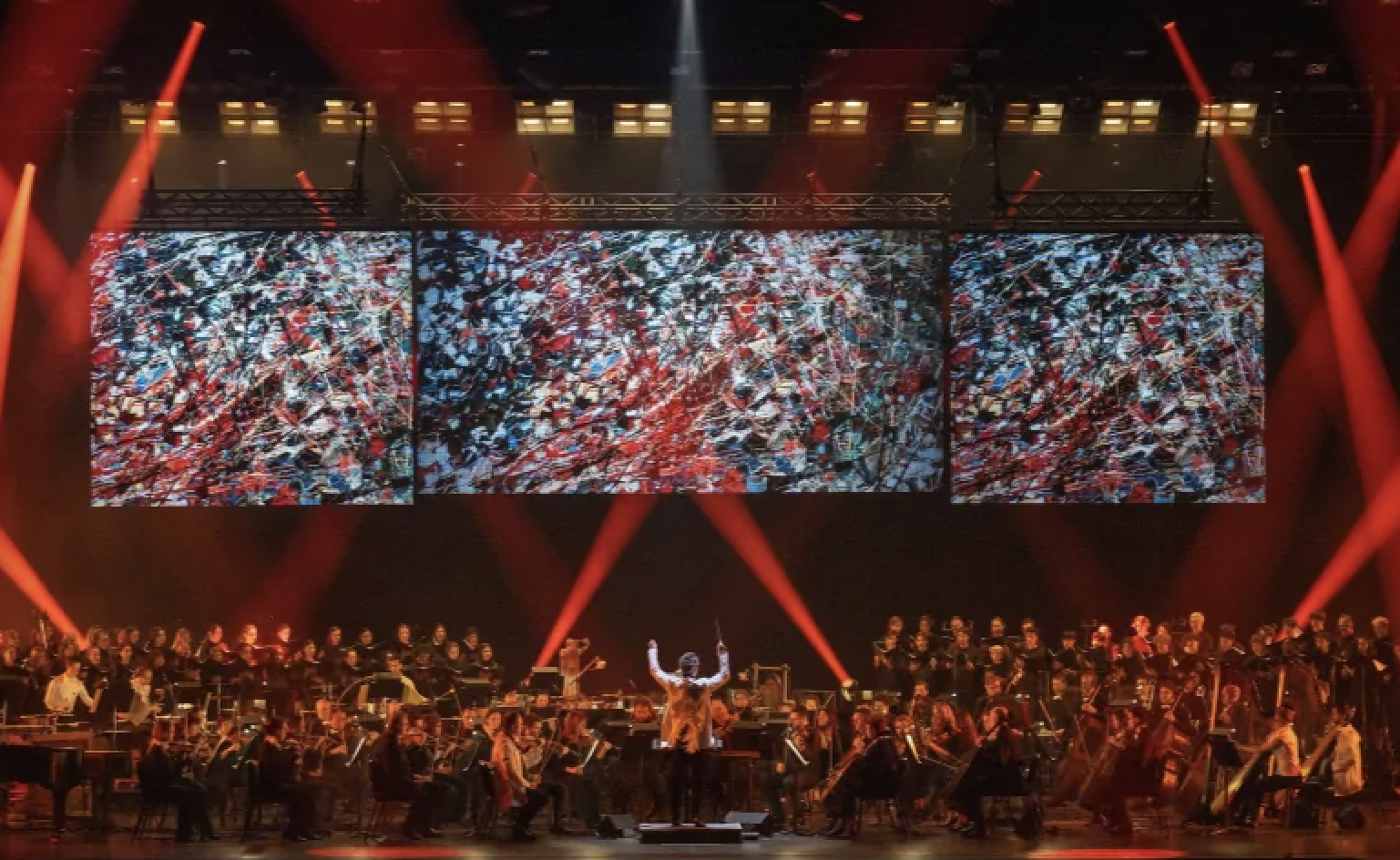Music review: Vancouver Symphony Orchestra and Vancouver Bach Choir deliver plenty of grandeur, but little whimsy, in Riopelle Symphonique
The Audain Foundation’s presentation of the multimedia tribute to Jean Paul Riopelle offered stunning visuals and stirring music in epic, serious production
Images from Jean Paul Riopelle’s Sans Titre (1950), detail, on screen, during the Quebec premiere of Riopelle Symphonique. Photo by Victor Diaz Lamich
The Audain Foundation presented Riopelle Symphonique with the VSO and Vancouver Bach Choir, at the Orpheum Theatre on April 20
THERE WAS A celebratory atmosphere at the Orpheum on Saturday night, as the minutes ticked down to the B.C. premiere of Riopelle Symphonique, a multimedia celebration of renowned Quebec artist, Jean-Paul Riopelle.
Paintings by Arts Umbrella students, inspired by Riopelle, were displayed in the upstairs lobby, while a prelude concert of original compositions written and performed by students of the VSO School of Music drew a huge crowd that was charmed by the earnest young musicians, whose works ranged from classical to jazz fusion. Attendees snapped photos; young siblings cheered; and parents beamed with pride. (Bassist Allison Lee and percussionist Paloma Delisle were particular standouts, displaying solid rhythm and sensitivity as they lent their talents to a number of the pieces.)
Of course, the big draw of the evening was the “multisensory experience”, presented by the Audain Foundation: a five-part work with original music by legendary singer songwriter Serge Fiori and composer Blair Thomson, with video projections of Riopelle paintings and sculptures. Originally conceived and produced by GSI Musique, in partnership with the Riopelle Foundation, this was Riopelle Symphonique’s first performance outside Quebec, featuring the Vancouver Symphony Orchestra and Vancouver Bach Choir, with conductor Adam Johnson. The big question hanging in the air was: Will it work? The answer, when it came, was: Mostly.
Act 1, “Emerging”, as the first movement was termed, was an exploration of the 1930s and ’40s, when Riopelle first began seriously studying art. It opened with an evocation of bird sounds, with twittering woodwinds and brass punctuations, underpinned by ethereal harmonics in the strings. These gave way to haunting staggered glissandos, first in the violins and cellos, and then in the voices. Images of Riopelle’s early watercolours and ink drawings appeared in sharp detail on the three screens above the performers: robins, finches, ducks, hawks.
The choir moved through different incantations: “Jamais, jamais” (“Never, never”); “Ça nous arriverait” (“It will come to us”); “On est tellement parfait” (We are so perfect) as the orchestra swirled with interlacing rhythms. Dramatic, yes, but also quite entrancing, despite the choral voices sounding slightly strained as they pushed to be heard over the instruments. When it concluded, a brief audio snippet of Riopelle followed, in which the artist humorously explained, in French, that he hadn’t wanted to paint in his iconic thick layers, and that, “When I learn to paint better, I will paint less thickly.”
Act 2, “Movement and international breakthrough,” examined Riopelle’s 1950s, in which he abandoned the paintbrush for the palette knife. Gone were the gentle images of feathered creatures, replaced with bold slashes of paint and colours, echoed in the intricate rhythms of the orchestra—rattling castanets, clashing triplets and duplex. The images moved rapidly, with the voices clamouring percussive syllables, “ka ka ti ka”, and the orchestra driving fractured repetitions.
Act 3, “Between abstraction and representation,” investigated Riopelle’s metallic sculptures of the 1960s. Sustained notes from the brass were layered with droning strings, building up into a cinematic crescendo, almost drowning out the staccato voices delivering insistent 32nd-note “ta ka” vocalizations. It was here that the program began to lag, moving from delight to melodrama. The whimsy in the images appearing on the screens—abstract dancing bears, owlish figures—seemed absent from the music, which felt like something that might accompany clashing swords rather than joyful creation.
“Nature is my only reference,” intoned Riopelle’s voice, before Act 4, “Libertas: The call of the land”, dove into his 1970s, a time during which he returned from Europe to the north of Quebec. Amid hypnotic repeated rhythmic patterns, the sharp tapping of stones rang out from the percussion, and the music swelled with sentiment as a rainstick was slowly tipped. Close-ups and animated lines filled the screens, as the images morphed from one work into another, some more figurative, others abstract.
Act 5, “Return to the sources,” began with a piece of film showing a group of snow geese—animals beloved by Riopelle—taking flight. Rendered with sharp contrast, their flapping black-tipped wings created shimmering, fractured lines. It looked not unlike a Riopelle canvas. Point taken. Stunning artworks from the 1980s and 1990s (Riopelle stopped painting in 1992, though he lived until 2002) filled the screens, with white-geese imagery everywhere—wings, heads—rendered in the stencil, acrylic, and spray-paint style of his stunning L’Hommage à Rosa Luxemburg tryptich. The music took a dark and sombre turn, the voices ringing out a Sanskrit mantra with increasing urgency.
It was big. It was grand. And it was all very serious, which is where Riopelle Symphonique falters. After all, Riopelle was a man who, in 1990, took part in a CBC interview sporting a baseball cap covered in fake bird poop and the words “Damn seagulls.” While the program certainly exuded passion, with moments of great beauty, something was missing: a spirit of playfulness amid all the gravitas.
![]()













